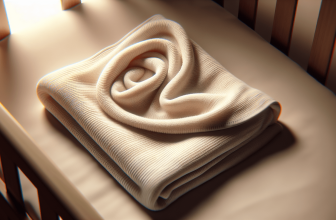Imagine waking up in the morning to see your adorable baby stretching in their sleep. You might find yourself wondering, what does it mean when your baby stretches like this? Is it a sign of discomfort, or is it indicative of something else? In this article, we will explore the various reasons behind your baby’s stretches during sleep and help you better understand what they could mean. So, grab a cup of coffee and get ready to unravel the fascinating mysteries of your baby’s sleepy stretches!
Understanding Baby Sleep Patterns
When it comes to baby sleep, understanding their sleep patterns is essential for ensuring their overall well-being. Babies have unique sleep cycles, which differ from those of adults. By familiarizing yourself with the different stages of baby sleep, you will be better equipped to promote healthy and restful sleep for your little one.
Different Stages of Baby Sleep
Just like adults, babies cycle through various sleep stages during their slumber. These stages include light sleep, deep sleep, and REM (Rapid Eye Movement) sleep. Light sleep is characterized by frequent interruptions and movement, while deep sleep is when the baby is in a state of relaxation with minimal movement. REM sleep is associated with dreaming and increased brain activity.
Understanding the different sleep stages helps you recognize when your baby is experiencing certain sleep patterns, such as stretching.
The Role of Stretching in Baby Sleep
Stretching is a common occurrence during baby sleep and serves several purposes. When babies stretch during their sleep, it can indicate healthy development and growth. Stretching also plays a role in muscle relaxation, improved blood circulation, and the release of tension.
By observing and understanding your baby’s stretching in sleep, you can ensure that they are experiencing the benefits and promoting their overall well-being.
Importance of Observing Baby’s Sleep Patterns
Observing your baby’s sleep patterns is crucial in understanding their overall health and well-being. By paying attention to their sleep behaviors, you can identify any abnormalities or potential issues early on. This allows you to take proactive steps to address them and ensure your baby’s optimal sleep.
Moreover, observing your baby’s sleep patterns helps you establish a consistent routine and identify any discomfort they may be experiencing during sleep. Making necessary adjustments to their sleep environment and routine can lead to better sleep quality for both you and your baby.
Possible Reasons for Baby’s Stretching in Sleep
Babies stretch in their sleep for various reasons, and it’s important to understand the possible causes behind this behavior. By knowing the potential reasons, you can gain insights into your baby’s development and address any concerns that may arise.
Natural Reflexes
Some stretching movements are instinctual and serve as natural reflexes. These reflexes help babies strengthen their muscles and prepare them for future movements and developmental milestones. It’s common for babies to stretch their arms, legs, and even their whole body during sleep as a way to exercise their muscles.
Growth and Development
Babies grow and develop at a rapid rate, and stretching plays a significant role in this process. As their bodies grow, their muscles and joints need regular stretching to support their development. Stretching in sleep allows babies to promote healthy growth and prepare their bodies for new skills, such as crawling and walking.
Muscle Relaxation
Stretching is a natural way for babies to relax their muscles and release any tension or stiffness. Similar to how adults stretch to unwind after a long day, babies also use stretching as a means of muscle relaxation during sleep. This process helps them feel more comfortable and promotes a better quality of sleep.
Discomfort or Pain
In some cases, stretching during sleep can be a response to discomfort or pain. Babies may stretch to alleviate any physical discomfort or muscle soreness they may be experiencing. It’s important to be mindful of any signs of discomfort or pain during sleep, as these may require further investigation and medical attention.

Significance of Baby’s Stretching in Sleep
The stretching movements your baby makes during sleep hold significant importance for their overall well-being and development. By understanding the significance behind these stretches, you can ensure that your baby is thriving and promote their optimal health.
Indication of Healthy Development
When your baby stretches during sleep, it is typically a positive indication of their healthy development. It shows that their muscles are growing and being exercised regularly. Regular stretching helps strengthen their muscles and prepares them for future physical milestones.
Improvement in Muscle Tone
Stretching helps improve your baby’s muscle tone. During sleep, when they stretch their limbs or whole body, it promotes muscle flexibility and strength. This improved muscle tone aids in the development of gross motor skills, such as rolling over, sitting, and eventually crawling.
Enhanced Blood Circulation
Stretching stimulates blood flow to your baby’s muscles, enhancing circulation. Improved blood circulation brings vital nutrients and oxygen to their growing muscles, promoting their overall health and development. Adequate blood flow also aids in the healing process and helps prevent any muscle stiffness or soreness.
Release of Tension
Just like adults, babies can experience tension and stress. Stretching during sleep allows your baby to release any accumulated tension, promoting relaxation and better sleep quality. By stretching, they can alleviate any discomfort or tightness they may be feeling, leading to a more peaceful and restful sleep.
Different Types of Baby Stretches
Babies exhibit various stretching movements during sleep, each serving its purpose in their development and well-being. By recognizing the different types of baby stretches, you can gain insights into your baby’s current state and ensure their comfort.
Arms and Legs Extension
One common type of baby stretch is the extension of their arms and legs. During sleep, babies often stretch their limbs to promote flexibility and muscle strength. These stretches help prepare their bodies for future physical milestones like reaching and grabbing objects, kicking, and eventually walking.
Back Arching
Back arching is another type of stretch that babies may perform during sleep. This movement involves the baby arching their back in a gentle curve. Back arching stretches the muscles along their spine and promotes overall flexibility and muscle tone. It is commonly seen as a way for babies to release any tension or discomfort.
Yawning and Jaw Stretching
Yawning and jaw stretching are natural movements that babies make during sleep. Yawning helps regulate their oxygen levels, while jaw stretching aids in the development and strengthening of facial muscles. These stretches are essential for overall oral muscle development and preparing the baby for expressions and eating.
Whole Body Stretch
The whole-body stretch is when babies stretch their entire body while sleeping. This stretch helps release tension throughout their muscles and promotes relaxation. It allows the baby to decompress and find comfort, ultimately leading to a more peaceful and uninterrupted sleep.
Observing Baby’s Sleep Environment
Creating a comfortable and conducive sleep environment is essential for promoting healthy sleep in babies. By observing and optimizing their sleep environment, you can ensure that your baby is set up for a restful night’s sleep.
Temperature
Maintaining an appropriate temperature in the sleep environment is important for your baby’s comfort. Babies tend to sleep best in a slightly cooler room, around 68-72 degrees Fahrenheit (20-22 degrees Celsius). Ensuring the temperature is neither too hot nor too cold helps prevent discomfort and promotes quality sleep.
Comfortable Bedding
Providing your baby with comfortable bedding is crucial for their sleep quality. Choose a mattress that is firm and fits the crib or bassinet properly to reduce the risk of suffocation or Sudden Infant Death Syndrome (SIDS). Use a fitted sheet that is tightly secured, avoiding loose blankets or pillows in the sleeping area.
Light and Noise Levels
Babies thrive in a sleep environment that is dimly lit and quiet. Low lighting helps signal to your baby’s body that it’s time to sleep. Consider using blackout curtains to block out excessive light. Minimize noise disturbances by using white noise machines or calming music to create a soothing atmosphere that promotes better sleep.
Recognizing Abnormal Stretches or Movements
While stretching is a normal part of a baby’s sleep, it’s important to be vigilant and recognize any abnormal stretches or movements that may indicate an underlying issue. By being aware of these signs, you can promptly address any concerns and seek appropriate medical advice if needed.
Disturbed Sleep Patterns
If your baby’s stretches or movements during sleep are excessive and disrupt their sleep patterns, it may indicate an underlying problem. Consistently disturbed sleep patterns characterized by restlessness, frequent awakenings, or prolonged periods of wakefulness may require further investigation and intervention.
Excessive or Jerky Movements
In some cases, excessive or jerky movements during sleep can be cause for concern. These movements, accompanied by unusual sounds or limb flailing, may suggest a neurological issue or a disrupted sleep cycle. Consulting a pediatrician is advisable if these movements persist or worsen over time.
Unusual Facial Expressions
While it’s common for babies to make facial expressions during sleep, certain facial expressions may indicate discomfort or pain. If your baby consistently exhibits grimacing, frowning, or other signs of discomfort during their stretches, it’s essential to investigate potential causes and seek medical advice if necessary.
Consulting a Pediatrician
If you have any concerns about your baby’s stretching or sleep patterns, it’s always a good idea to consult a pediatrician. They can provide professional guidance, evaluate your baby’s overall health, and address any specific concerns you may have.
When to Seek Medical Advice
Knowing when to seek medical advice is crucial for ensuring your baby’s well-being. If your baby’s stretches or movements during sleep are consistently disruptive, accompanied by signs of discomfort or pain, or if you notice any sudden changes in their sleep patterns, it’s advisable to reach out to your pediatrician. They can assess your baby’s condition and provide appropriate recommendations.
Sharing Observations and Concerns
When consulting a pediatrician, it’s important to share your observations and any concerns you may have regarding your baby’s stretching or sleep patterns. Providing detailed information about the frequency, duration, and nature of their stretches will help the pediatrician assess the situation more effectively. Be open and honest about any changes in their sleep routine or additional symptoms you may have noticed.
Medical Evaluation and Diagnosis
A pediatrician will conduct a thorough medical evaluation to assess your baby’s overall health and determine the underlying causes of their stretches or abnormal sleep patterns. They may recommend further diagnostic tests or refer you to a specialist if necessary. With their expertise, they can provide a proper diagnosis and develop an appropriate treatment plan, if needed.
Tips for Promoting Healthy Sleep
Promoting healthy sleep habits for your baby is crucial for their growth and development. By implementing these tips into your daily routine, you can create a conducive sleep environment and establish healthy sleep patterns for your little one.
Establishing a Bedtime Routine
Establishing a consistent bedtime routine helps signal to your baby that it’s time to wind down and prepare for sleep. A bedtime routine can include activities such as a warm bath, gentle massage, reading a bedtime story, or singing lullabies. By repeating the same sequence of activities each night, your baby will associate them with sleep and gradually develop a regular sleep schedule.
Creating a Calming Environment
Creating a calm and soothing sleep environment is essential for promoting healthy sleep. Dim the lights and reduce noise levels to create a relaxing atmosphere. Using soft and comforting bedding, such as a sleep sack or swaddle, can help your baby feel secure and comfortable during sleep. Consider utilizing white noise machines or gentle music to drown out any background noises and provide a calming ambiance.
Proper Feeding and Burping
Ensuring that your baby is well-fed and burped before sleep plays a significant role in their sleep quality. Avoid overfeeding, as it can lead to discomfort and reflux. Burping your baby after each feeding helps release any trapped gas and reduces the chances of discomfort or spitting up during sleep. Establishing a feeding and burping routine can help regulate your baby’s digestion and promote better sleep patterns.
Avoiding Overstimulation
Babies are highly sensitive to their surroundings, and overstimulation can hinder their ability to fall asleep or maintain a restful sleep. Avoid exposing your baby to excessive screen time, loud noises, or stimulating toys before bedtime. Engage in calm and soothing activities in the evening to help them unwind and transition into sleep mode.
Common Sleep Issues in Babies
While most babies go through periods of good sleep, they may also encounter certain sleep issues along the way. Understanding common sleep issues can help you navigate these challenges and provide the necessary support for your baby’s sleep.
Sleep Regressions
Sleep regressions are temporary disruptions in a baby’s sleep patterns. They often occur around developmental milestones or growth spurts. During these periods, babies may have difficulty falling asleep, experience frequent awakenings, or have shortened sleep cycles. Consistency in your baby’s sleep routine and providing comfort during these regressions can help them navigate these temporary disruptions.
Night Wakings
Night wakings are common in babies, especially during their first year of life. Babies have shorter sleep cycles than adults, so it’s natural for them to wake up during the night. However, if your baby consistently has difficulty falling back asleep or showing signs of discomfort or hunger, it’s important to address these issues to promote better sleep.
Transitioning to Longer Sleep Periods
As your baby grows, they will naturally transition to longer sleep periods, such as longer naps and sleeping through the night. However, this transition can vary for each baby and may require some adjustments. Gradually extending their awake times, ensuring they are well-fed, and creating a consistent sleep routine can support their transition to longer sleep periods.
Conclusion
Understanding your baby’s sleep patterns and behaviors is essential for ensuring their overall well-being and development. By recognizing the significance of their stretching during sleep, you can support their healthy growth, muscle development, and relaxation. By creating a comfortable sleep environment, addressing any concerns, and implementing healthy sleep practices, you can promote optimal sleep for your baby. Remember to consult a pediatrician if you have any concerns or questions regarding your baby’s sleep patterns or stretching behaviors. With proper care and attention, you can help your baby thrive and enjoy restful and rejuvenating sleep.










